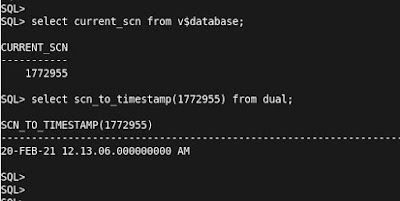Session details associated with Oracle SID
set head off
set verify off
set echo off
set pages 1500
set linesize 100
set lines 120
prompt
prompt Details of SID / SPID / Client PID
prompt ==================================
select /*+ CHOOSE*/
'Session Id.............................................: '||s.sid,
'Serial Num..............................................: '||s.serial#,
'User Name ..............................................: '||s.username,
'Session Status .........................................: '||s.status,
'Client Process Id on Client Machine ....................: '||'*'||s.process||'*' Client,
'Server Process ID ......................................: '||p.spid Server,
'Sql_Address ............................................: '||s.sql_address,
'Sql_hash_value .........................................: '||s.sql_hash_value,
'Schema Name ..... ......................................: '||s.SCHEMANAME,
'Program ...............................................: '||s.program,
'Module .................................................: '|| s.module,
'Action .................................................: '||s.action,
'Terminal ...............................................: '||s.terminal,
'Client Machine .........................................: '||s.machine,
'LAST_CALL_ET ...........................................: '||s.last_call_et,
'S.LAST_CALL_ET/3600 ....................................: '||s.last_call_et/3600
from v$session s, v$process p
where p.addr=s.paddr and
s.sid=nvl('&sid',s.sid)
/
Active Sessions running from more than 1 hour
set pages 50000 lines 32767
col USERNAME for a10
col MACHINE for a15
col PROGRAM for a40
SELECT USERNAME,machine,inst_id,sid,serial#,PROGRAM,
to_char(logon_time,'dd-mm-yy hh:mi:ss AM')"Logon Time",
ROUND((SYSDATE-LOGON_TIME)*(24*60),1) as MINUTES_LOGGED_ON,
ROUND(LAST_CALL_ET/60,1) as Minutes_FOR_CURRENT_SQL
From gv$session
WHERE STATUS='ACTIVE'
AND USERNAME IS NOT NULL and ROUND((SYSDATE-LOGON_TIME)*(24*60),1) > 60
ORDER BY MINUTES_LOGGED_ON DESC;
SQLs Running from longtime
alter session set nls_date_format = 'dd/mm/yyyy hh24:mi';
set pages 50000 lines 32767
col target format a25
col opname format a40
select sid
,opname
,target
,round(sofar/totalwork*100,2) as percent_done
,start_time
,last_update_time
,time_remaining
from
gv$session_longops
/
select inst_id,SID,SERIAL#,OPNAME,SOFAR,TOTALWORK,
START_TIME,LAST_UPDATE_TIME, username from gv$session_longops;
Session details with SPID
select sid, serial#, USERNAME, STATUS, OSUSER, PROCESS,
MACHINE, MODULE, ACTION, to_char(LOGON_TIME,'yyyy-mm-dd hh24:mi:ss')
from gv$session where paddr in (select addr from gv$process where spid = '&spid')
/
To find Undo Generated For a given session
select username,
t.used_ublk ,t.used_urec
from gv$transaction t,gv$session s
where t.addr=s.taddr and
s.sid='&sid';











